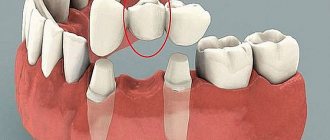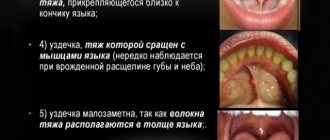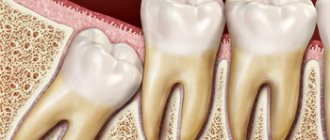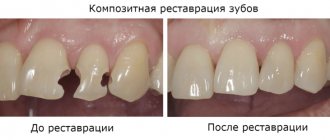How inflammation begins
All about dental health
How to maintain beautiful healthy teeth? We tell you in detail: - how to brush your teeth correctly, - how to choose a toothbrush, - how to choose other devices for cleaning your teeth, - how to choose toothpaste, - how to preserve tooth enamel, - how to care for your first teeth, - how to use calcium for dental health. , - how sugar and other foods affect dental health, - how to use chewing gum correctly, - what are the misconceptions about dental health.
Gum inflammation, or
gingivitis
, is caused by bacteria that grow in plaque.
They penetrate under the gums and release enzymes and toxins. At the same time, the gums change color. It turns red if the inflammation is acute, or becomes bluish if the process has entered a chronic stage - and swells. However, the first sign of inflammation that you will notice on your own is bleeding gums
when brushing your teeth or eating solid foods.
How to keep your teeth healthy into old age
To the question “How to keep your teeth healthy?” dentists answer that they need to be taken care of even before birth. In order for the unborn child to develop healthy teeth, a pregnant woman must eat properly.
And then, when the baby is born, it is necessary not only to know the secrets of how to keep teeth healthy until old age, but also to constantly use them. They are simple and fit well into our everyday life.
Since we want to keep our teeth healthy longer (preferably into old age), it is necessary:
- Visit the dentist at least once every six months. The doctor will not only assess the condition of the oral cavity or prescribe additional diagnostics (for example, an X-ray), but will also recommend means of disease prevention (possibly traditional ones).
- Practice proper oral hygiene. You need not only to brush your teeth twice a day, but also to choose the right products (brush, paste, rinse, etc.), clean your tongue, use floss, follow sanitary rules, etc., as recommended by your doctor.
- Protect your teeth from sugar and acids, which destroy enamel and are found in carbonated drinks, fruit juices, candies, etc.
- Eat right (eat foods with calcium and vitamin D).
- Regulate the load on the teeth. That is, do not open nuts with your teeth, but still eat raw apples, carrots, etc.
There are other secrets to keeping teeth healthy into old age (for example, remineralization). But they belong to professional means of prevention and are prescribed individually.
See a doctor immediately
If your gums are bleeding, you need to see a dentist as soon as possible in order to begin treatment while the inflammation in the gums is still reversible. Without appropriate treatment, inflammation will progress and may progress to the next, more severe stage – periodontitis. This is the destruction of the bone tissue of the tooth socket and the formation of a periodontal pocket - the space between the tooth root and the gum. In this case, the tooth becomes mobile and, with significant bone destruction, falls out. By the way, periodontitis
is one of the most common causes of tooth loss.
How to avoid gum disease
- Visit your dentist
- at least twice a year.
A specialist will examine your oral cavity, teach you how to brush your teeth, select the hygiene products you need, and carry out professional removal of dental deposits - plaque and tartar. — Take regular and thorough oral care
: brush your teeth with a toothbrush and toothpaste, use dental floss and mouth rinses as recommended by your dentist.
— To prevent and treat
the early stages of gum inflammation, use toothpastes and rinses containing extracts of medicinal plants and essential vegetable oils.
Consult your dentist - he will select the most suitable products for you and tell you how to alternate them so that addiction does not occur. - Toothpastes and rinses with antiseptics
- chlorhexidine, triclosan, cetylpyridine chloride - are usually prescribed in the presence of inflammation.
The duration of the course of using these drugs is determined by the dentist. It is necessary to follow his recommendations to avoid negative effects on the normal microflora of the oral cavity and the appearance of dysbacteriosis. — Gum massage
helps improve blood circulation.
It can be done every time you brush your teeth - at the end of brushing, making light circular movements with the toothbrush with your teeth closed. — Hydromassage
of the gums can be done using irrigators - special devices that precisely deliver a stream of water or an antiseptic solution under pressure from 0.7 to 4.8 bar.
— Clean the interdental spaces very carefully
so as not to injure the gingival papillae located between the teeth. Chronic trauma from dental floss or toothpicks can cause changes in their contour and the formation of gaps between the teeth.
Formation of gums during dental implantation
Formation of the gingival contour is one of the most important stages in implant prosthetics.
It depends on the gums how your crown on an implant will look, how indistinguishable it will be from your own tooth, how physiological and comfortable it will be.
So, when the installed implants are integrated and the patient comes for prosthetics, the implantation area is a flat area of \u200b\u200bthe gums with protruding formers.
If you unscrew the gum formers, you will see just “holes” in the gums with implants in the depths.
Prosthetics with permanent crowns in conditions of immature gums will not give the desired result. Very often the crowns in such cases look like mushroom caps on a stem. That is, a wide upper part of the crown at the level of the chewing surface and a significantly narrowed part of the crown in the gingival area. Or they make crowns with edges and undercuts hanging over the gums, because it is not possible to install a crown on an implant in any other way due to the density and volume of the gums. All this gives only a short-term positive effect and the joy of new teeth gives way to disappointment, since the overhanging edges of the crown are difficult to clean, smell and inflammation of the gums appear. Due to prolonged irritation, the gums sag, further aggravating the situation. Naturally, appearance also suffers.
All this threatens a more serious complication – peri-implantitis!
To avoid many problems with prosthetics on implants, you need to correctly form the gum.
Gum formation is carried out with temporary crowns for at least 3 months. You can read about temporary crowns here…….
With all this, despite the name, temporary crowns are already full-fledged teeth both anatomically and functionally, but thanks to the material from which they are made (plastic or composite), adjustments in shape are possible to achieve the desired gum profile.
There may be several such adjustments, depending on the result achieved, and they are carried out approximately once a month.
What size should the gums be in the area of crowns on implants?
Between the crown and the natural tooth, as well as between the crowns on implants, interdental papillae must be formed, just like in natural teeth.
Only in this case we will not get “black triangles” between the crowns and the crowns on the implants will look as natural as possible.
Another requirement when forming gums is that there must be sufficient gum volume not only on the side of the tooth or adjacent crown, but also on the side of the cheek or palate!!! That is, along the entire perimeter of the implant!!!
An example of gum formation in the area of the installed implant 46.
Fixation of the temporary crown in all cases is only screw, no cement! The crown should move smoothly from the gum level towards the implant. During the fixation of the temporary crown, the gums are compressed and displaced. This procedure is performed under local anesthesia to avoid discomfort. The temporary crown is gradually, sometimes within 5-10 minutes, screwed onto the implant; faster and more aggressive fixation of the crown can lead to significant ischemia and necrosis of the gums. Therefore - no rush!
A fixed permanent crown should best match the tooth being restored, both functionally and aesthetically!
If the permanent crown is fixed with cement, an individual abutment is made along the formed gum contour and the crown is subsequently fixed onto it.
The abutment in this situation looks like a tooth that has been ground down for a crown.
The formation of gums in the case of manufacturing a bridge supported by implants also has its own characteristics. Since there is an intermediate overhanging part, it is necessary to create such a gum profile and such a shape of the intermediate part (facet) so that hygiene is maintained in this area as physiologically as possible. What does it mean? Since we cannot avoid the intermediate part and, as a consequence, the possibility of food residues getting under this part, we need to make this area accessible for hygiene and self-cleaning.
The intermediate (overhanging) part should not have overhangs or undercuts, it should not sit on the gum like a saddle, but be convex and absolutely smooth. If food remains stuck in this area, the smooth and convex surfaces will allow you to clean this surface without any problems.
This approach is used for prosthetics of both lateral and frontal areas.
The intermediate part can also be modified at the stage of temporary crowns until the optimal shape of this area is achieved.
All these manipulations with the gums are performed by an orthopedist. However, it is the surgeon’s task to create sufficient gum volume above the implant. It is the implant surgeon who, taking into account the gum biotype and the planned design of the future prosthesis, must carry out the correct installation of the implant. If there is not enough soft tissue above the integrated implant, then no prosthodontist will be able to create an optimal gingival contour. Plastic surgery to increase gums is often ineffective or the results do not last long.
The examples shown above are just special cases. Each person is unique and requires an individual approach! However, the stage of temporary prosthetics and the formation of the gingival contour is mandatory for everyone.
Eat right
— Eat less foods rich in fast carbohydrates. These include flour products, sweets, and many fast food products. They contribute to increased plaque
and serve as a breeding ground for pathogenic bacteria that destroy teeth and gums.
- Include solid foods
- raw vegetables, hard fruits - that require intensive chewing, which leads to an increase in saliva flow and natural cleansing of the oral cavity.
It is advisable to eat hard vegetables and fruits after eating sweet, sticky and soft foods. — Include a sufficient amount of protein
for normal renewal of the mucous membrane of the mouth and gums.
— Avoid developing hypovitaminosis. After all, pathological changes in the gums most often develop with a deficiency of vitamins
A, C and D.










